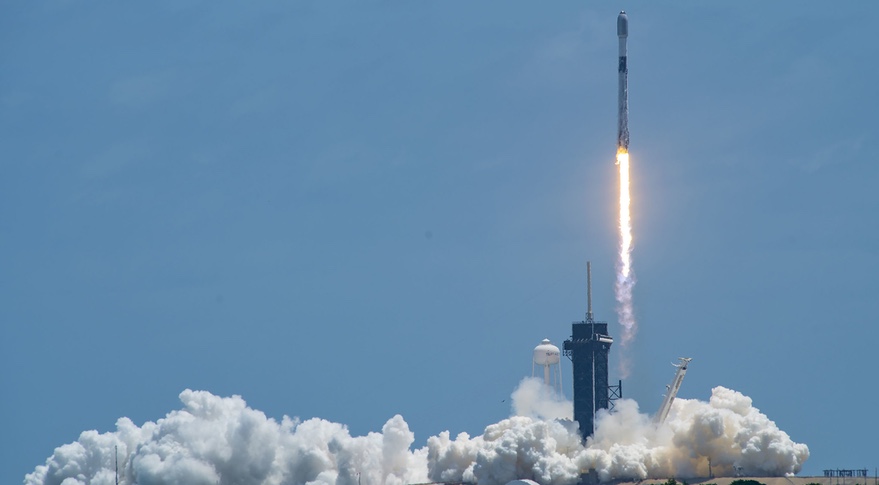WASHINGTON — SpaceX completed a surge of three successful launches in a little more than 36 hours early June 19, days after an open letter within the company critical of founder Elon Musk led to the firing of several employees.
The stretch of launches started June 17 with a Falcon 9 launch from Kennedy Space Center’s Launch Complex 39A. The rocket, lifting off at 12:09 p.m. Eastern, placed 53 Starlink satellites into orbit. The booster used for the launch completed its 13th flight with a droneship landing, setting a company record for booster reuse.
The second launch took place at 10:19 a.m. Eastern June 18 from Space Launch Complex 4E at Vandenberg Space Force Base in California. The Falcon 9 placed into orbit the SARah-1 radar imaging satellite, built by Airbus for the German military as a replacement for the existing SAR-Lupe system. SpaceX provided limited information about the launch, similar to restrictions for classified U.S. launches, but the German military later confirmed payload deployment and successful contact with the four-ton satellite. The booster, which flew two National Reconnaissance Office missions earlier this year, landed back at the launch site.
The final, and perhaps most mysterious, launch took place at 12:27 a.m. Eastern June 19 from Space Launch Complex 40 at Cape Canaveral Space Force Station in Florida. The only identified payload on the launch was Globalstar FM15, a spare satellite for low Earth orbit satellite operator Globalstar. That satellite deployed from the upper stage nearly two hours after liftoff.
Several aspects of the mission suggested to observers that Globalstar FM15 was not the only payload on the launch. That included an unusual set of three burns by the upper stage and the droneship landing of the first stage, even through the Globalstar satellite alone, weighing about 700 kilograms, was small enough to enable a landing back at the launch site.
SpaceX initially did not initially provide video of the payload after fairing separation, but did after the second burn. Those views showed not just the Globalstar satellite but also what appeared to be a payload adapter. That could mean the rocket also carried one or more payloads deployed after the upper stage’s first burn. It could also mean, though, that the launch was originally intended to carry additional payloads but launched without them.
Globalstar provided few details about its own satellite on the mission. The company did not publicize the launch in advance. In a statement after its quarterly earnings release May 5, Dave Kagan, chief executive of Globalstar, said the company was planning to launch that ground spare “in the coming months” that would, along with plans for a new set of satellites ordered earlier in the year, “ensure continuity of service to all of our existing and future subscribers as well as other users of the network.”
In its filing of its quarterly results with the Securities and Exchange Commission May 5, the company said the “vast majority” of the costs for both preparing Globalstar FM15 for launch and the launch itself were paid for by an unnamed customer. That same customer is also financing nearly all the costs of 17 new satellites Globalstar ordered from Canadian company MDA in February.
Internal criticism
The launches took place days after internal criticism of Elon Musk, founder of chief executive of SpaceX, erupted into public view. An open letter circulated within company networks June 15 said Musk’s public statements had become an “embarrassment” for some employees, distracting them from their work.
“Elon’s behavior in the public sphere is a frequent source of distraction and embarrassment for us, particularly in recent weeks,” the letter stated. “As our CEO and most prominent spokesperson, Elon is seen as the face of SpaceX — every Tweet that Elon sends is a de facto public statement by the company. It is critical to make clear to our teams and to our potential talent pool that his messaging does not reflect our work, our mission, or our values.”
The letter, first reported by The Verge, did not include any specific examples of behavior by Musk, although there is arguably no shortage of such cases. That includes not just controversial tweets but also a claim published in May that he sexually harassed a flight attendant on a SpaceX private jet in 2016, an account that Musk has strongly denied.
The letter called on SpaceX to “publicly address and condemn Elon’s harmful Twitter behavior” and “separate itself from Elon’s personal brand.” It also demanded that the company’s leadership be held “equally accountable” for addressing workplace issues, and better define its “zero tolerance” policies for unacceptable behavior. Company sources, speaking on background because they are not authorized to speak publicly, said they believed several hundred employees had endorsed the letter before it was taken off company networks.
Neither Musk nor SpaceX did not respond publicly to the open letter. However, in a memo to company employees June 16, SpaceX President Gwynne Shotwell said it had fired “a number of employees” involved with the open letter. The New York Times first reported the firings.
Shotwell, in the memo, claimed that “the letter, solicitations and general process made employees feel uncomfortable, intimidated and bullied, and/or angry because the letter pressured them to sign onto something that did not reflect their views.” Disseminating the letter, she said, went against company policies “and does not show the strong judgment needed to work in this very challenging space transportation sector.”
Shotwell said the letter was a distraction for the company as it worked on activities that included the three launches that were coming up. “We have 3 launches within 37 hours for critical satellites this weekend,” she wrote, as well as work on cargo and crew Dragon spacecraft and being “on the cusp” of an orbital Starship launch. “We have too much critical work to accomplish and no need for this kind of overreaching activism.”
